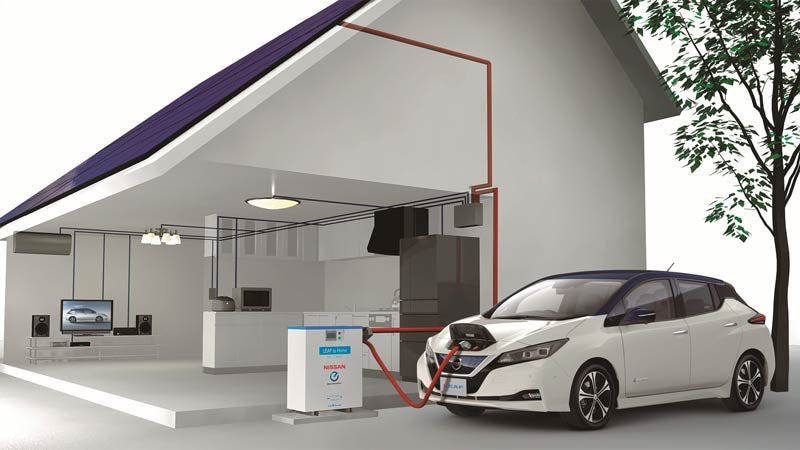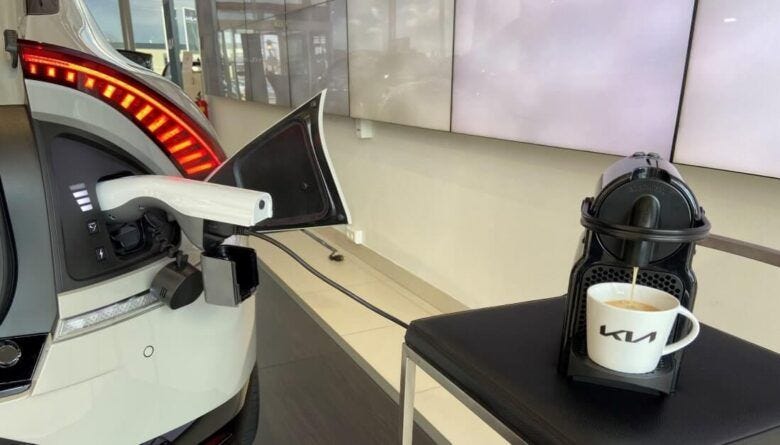Year 2049 is your fun weekly guide to the impactful innovations, discoveries, and research shaping our future.
If this was forwarded to you, subscribe for free to get a new story in your inbox every Friday.
Hello friends 👋
The benefits of electric vehicles are clear. Road vehicles account for 12% of global emissions and electrification is a crucial step to achieve the Paris Agreement goals.
I went down the rabbit hole of electric vehicles this week and learned about an interesting new feature that’s being added to the latest models: bidirectional charging. And it can completely change the way we store and supply electricity.
Read along and enjoy.
– Fawzi
Today’s Edition
Comic: The car and the storm 🌪
Story: Bidirectional charging 🔋
What is bidirectional charging?
The 3 types of bidirectional charging
The benefits of bidirectional charging
What’s next for the technology
Comic
Bidirectional Charging 🔋
Storing and supplying renewable energy storage
Automakers have been adding bidirectional charging capabilities to their latest electric vehicles (EVs).
Unlike traditional EVs, these vehicles can discharge their energy to an external source like your home. This turns each vehicle into a large and powerful battery on wheels.
Even more exciting: it can allow EVs to store energy from renewable sources like solar and wind power, which are only accessible when the sun is shining or the wind is blowing. With bidirectional charging, you could charge your car using solar power and then use that energy whenever you want.
There are 3 types of bidirectional charging you should know about:
V2G → Vehicle-to-Grid
V2H → Vehicle-to-Home
V2L → Vehicle-to-Load
V2G: Vehicle-to-Grid
V2G enables electricity to be pushed from an EV’s battery back into the power grid.
What does that mean exactly?
Demand for electricity varies throughout the day. When the demand is high, EV owners can “sell” the surplus electricity stored in their vehicles for reduced electricity costs or other incentives. Even if an EV has bidirectional charging capabilities, participation in V2G is entirely up to the owner of the vehicle.
Scandinavian startups Tibber (Norway) and Virta (Finland) have already started implementing V2G technology in the Netherlands, Norway, Finland, Sweden, and Germany.
We ran some calculations and demonstrated that an early-adopter market like Norway could have all of its grid flexibility requirements provided by EVs sometime between 2025 and 2030.
– Edgeir Aksnes, CEO and co-founder of Tibber, in an interview with Green Tech Media
A white paper from Nissan, E.ON Drive, and Imperial College estimates that V2G can help deliver overall power system cost savings of up to £885 million per year.
I’ve linked a 2-minute video at the end to show you what V2G looks like in practice.
V2H: Vehicle-to-Home
V2H allows you to use an EV like a home battery system. This could come in handy if you want to power your home at night using energy generated by solar power during the daytime. Or if you want to power your home after a storm causes a power outage.
The average battery capacity for EVs is 60 kWh, and some models go up to 100 kWh. An average household uses around 30 kWh/day, which means an EV like the Ford F-150 Lightning could fully power a home for 3 days. Pretty cool, right?
V2L: Vehicle-to-Load
V2L involves charging individual items by plugging them straight into an EV, the same way you would plug them into a power outlet at home. Nothing groundbreaking, but definitely super helpful.
What’s next for bidirectional charging?
Although the Nissan Leaf has supported bidirectional charging since 2012, the technology has been picking up more steam in the past few years:
Introducing more EVs with bidirectional charging: Tesla, Ford, Mercedes, Volkswagen, Hyundai, and others are developing EVs with bidirectional charging.
Scaling the EV fleet: To reap the benefits of V2G, we would need a large network of electric cars with these capabilities. EV sales have been increasing every year for the past 10 years and will continue to do so. Keep an eye on Norway, which might become the first country to fully electrify its road vehicles: EV sales will account for 80% of their vehicle sales in 2022, per Reuters.
Standardizing V2G protocols: Currently, only vehicles following the Japanese CHAdeMO standard are capable of feeding energy back to the electric grid (V2G). The new European ISO 15118-20 standard, which is currently in the approval stages, will help standardize V2G protocols for more vehicles.
Final thoughts
I’m so glad I came across bidirectional charging when I went down the EV rabbit hole. I thought I already knew all the benefits of an EV, but bidirectional charging took that to a whole other level.
With V2G, power grid operators and consumers can both benefit from pooling together their resources and saving money, while also reducing overall emissions and increasing the amount of renewable energy we can store. By 2030, 145 million EVs are expected to be on the road globally so the potential is massive.
With V2H, people can now store up to 3 days’ worth of energy in their car which they can reuse whenever they want. It also gives them peace of mind when a power outage hits following a severe storm. What I found most interesting is the idea of using EVs as mobile storage units for renewable energy. I know that the Tesla Powerwall did that already, but it can only store 13.5 kWh compared to the average 60 kWh of an EV.
What still needs work is creating the systems and standards that will enable the use of V2G and V2L at scale. Ideally, all automakers should follow the same bidirectional charging standards and protocols so everyone involved can reap the maximum benefits.
Deep dive
If you enjoyed reading about bidirectional charging, I’ve compiled some additional links to satisfy your curiosity:
Virta’s V2G charging in practice (YouTube)
The first paper ever on V2G, written by Willett Kempton in 2001 (PDF)
A more technical explanation of bidirectional chargers (Clean Energy Reviews)
Start-up Next Kraftwerke's renewable virtual power plant stabilizes grid (Clean Energy Wire)
The Startup Helping EVs Balance Out the Renewables That Power Them (Green Tech Media)
How does ISO 15118 support vehicle-to-grid (V2G)? (Switch)
V2G research study on battery life (University of Warwick)
List of electric vehicle battery capacities for every model (Electric Vehicle Database)
Sharing is caring
The best way to support me is to invite others to subscribe to the Year 2049 newsletter.
Share Year 2049 by email, Twitter, WhatsApp or LinkedIn
or just share this link: https://year2049.substack.com/welcome
If you missed the previous episode
I talked about Colossal Biosciences and their plans to recreate the woolly mammoth using CRISPR gene editing. They raised an additional $60 million in funding this week 🤯
You can also check out all previous Year 2049 episodes in chronological order to learn about other interesting innovations in climate, transportation, science, food, and more.
How would you rate this week's edition?












I'm glad that V2H is becoming a reality. I've often wondered why we don't make car roofs into solar panels. They sit outside all day. And then, just as you were describing, we could fill up a battery with solar power and swap it into our homes. I can't wait for this to be more mainstream. But if it were, how would the utility companies that sell us electricity make their money?!
Could be helpful for the power outages in Lebanon! 😅